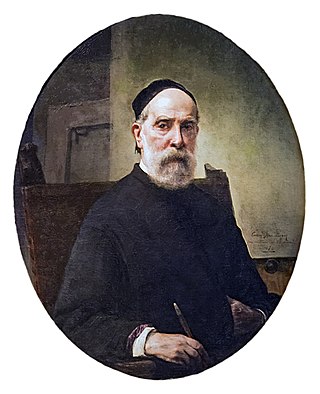Giuseppe Mentessi (29 September 1857 in Ferrara, - 14 June 1931 in Milan) was an Italian painter.

Giuseppe Mentessi (29 September 1857 in Ferrara, - 14 June 1931 in Milan) was an Italian painter.

He established himself as a painter in Milan, where he taught at the Brera Academy. He exhibited a triptych of the Madonna at the Biennale in Venice of 1897. [1] Described as having a mystic suavity and spiritual grace [2] many of his painters center upon an emotive representation of motherhood. Innocente Cantinotti and Antonio Sant'Elia were among his pupils.

Monza is a city and comune on the River Lambro, a tributary of the Po in the Lombardy region of Italy, about 20 kilometres north-northeast of Milan. It is the capital of the Province of Monza and Brianza. Monza is best known for its Grand Prix motor racing circuit, the Autodromo Nazionale di Monza, which hosts the Formula One Italian Grand Prix with a massive Italian support tifosi for the Ferrari team.

Cremona is a city and comune in northern Italy, situated in Lombardy, on the left bank of the Po river in the middle of the Pianura Padana. It is the capital of the province of Cremona and the seat of the local city and province governments. The city of Cremona is especially noted for its musical history and traditions, including some of the earliest and most renowned luthiers, such as Giuseppe Guarneri, Antonio Stradivari, Francesco Rugeri, Vincenzo Rugeri, and several members of the Amati family.

Francesco Hayez was an Italian painter. He is considered one of the leading artists of Romanticism in mid-19th-century Milan, and is renowned for his grand historical paintings, political allegories, and portraits.

Gaudenzio Ferrari was an Italian painter and sculptor of the Renaissance.

Ambrogio Borgognone was an Italian painter of the Renaissance period active in and near Milan.

Francesco Melzi, or Francesco de Melzi (1491–1570), was an Italian painter born into a family of the Milanese nobility in Lombardy. He became a pupil of Leonardo da Vinci and remained as his closest professional assistant throughout his career. After da Vinci's death he became the literary executor of all da Vinci's papers, editing them into a manuscript on painting he published as Tratatto della Pittura [Treatise on Painting] or a compilation entitled the Codex Urbinas.

Pellegrino Tibaldi, also known as Pellegrino di Tibaldo de Pellegrini, was an Italian mannerist architect, sculptor, and mural painter.

Daniele Crespi was an Italian painter and draughtsman. He is regarded as one of the most original artists working in Milan in the 1620s. He broke away from the exaggerated manner of Lombard Mannerism in favour of an early Baroque style, distinguished by clarity of form and content. A prolific history painter, he was also known for his portraits.

Andrea Appiani was an Italian neoclassical painter.

Alessandro Magnasco, also known as il Lissandrino, was an Italian late-Baroque painter active mostly in Milan and Genoa. He is best known for stylized, fantastic, often phantasmagoric genre or landscape scenes. Magnasco's distinctive style is characterized by fragmented forms rendered with swift brushstrokes and darting flashes of light.

Aldo Carpi was an Italian artist, painter and writer, author of a collection of memoirs concerning his imprisonment in the infamous Mauthausen-Gusen concentration camp.

Camillo Procaccini was an Italian painter. He has been posthumously referred to as the Vasari of Lombardy, for his prolific Mannerist fresco decoration.
Giovanni Gioseffo dal Sole was an Italian painter and engraver from Bologna, active in the late-Baroque period. Upon the death of Carlo Cignani, Gioseffo dal Sole became among the most prominent painters in Bologna, described as the Guido Moderno.

Giovanni Ambrogio de Predis was an Italian Renaissance painter, illuminator and designer of coins active in Milan. Ambrogio gained a reputation as a portraitist, including as a painter of miniatures, at the court of Ludovico Sforza.

Eleuterio Pagliano was an Italian painter of the Romantic period as well as an activist and fighter of the Risorgimento.

Luigi Pellegrini Scaramuccia (1616–1680) was an Italian painter and artist biographer of the Baroque period. He was a pupil, along with Giovanni Domenico Cerrini of the painter Guido Reni.

Giuseppe Vermiglio was a Caravaggist painter from Northern Italy, active also in Rome.

Cavalier Pietro Tempesta, or Pieter Mulier II was a Dutch Golden Age painter active in Italy.

The Hours of Giangaleazzo Visconti is a Roman-liturgy, illuminated Book of Hours in Latin, which was commissioned by the ruler of Milan, Gian Galeazzo Visconti, in Italy in the late 14th century. A Book of Hours is a personal prayer book that contained, in part, the Hours of the Virgin, a daily devotional that was popular at the time. This particular Book of Hours was created by two master illuminators, beginning with Giovannino dei Grassi before his death, and completed by Luchino Belbello da Pavia.

Gian Emilio Malerba (1880–1926) was an Italian painter and illustrator, one of the founders of the Novecento Italiano in Milan. He initially created works in a Liberty or Art Nouveau style.